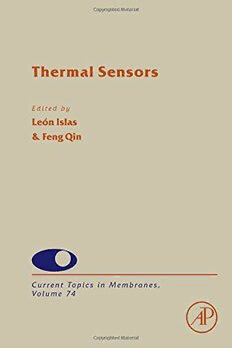
Thermal sensors PDF
Preview Thermal sensors
CURRENT TOPICS IN MEMBRANES, VOLUME 74 Series Editors ROBERT BALABAN National Heart, Lung and Blood Institute National Institutes of Health Bethesda, Maryland, USA SIDNEY A. SIMON Department of Neurobiology Duke University Medical Centre Durham, North Carolina, USA VOLUME SEVENTY FOUR C T URRENT OPICS IN MEMBRANES Thermal Sensors Edited by (cid:1) LEON D. ISLAS Department of Physiology, School of Medicine, National Autonomous University of Mexico (UNAM), Mexico City, Mexico FENG QIN Department of Physiology & Biophysics, State University of New York Buffalo, New York, USA Amsterdam(cid:129)Boston(cid:129)Heidelberg(cid:129)London NewYork(cid:129)Oxford(cid:129)Paris(cid:129)SanDiego SanFrancisco(cid:129)Singapore(cid:129)Sydney(cid:129)Tokyo AcademicPressisanimprintofElsevier AcademicPressisanimprintofElsevier 225WymanStreet,Waltham,MA02451,USA 525BStreet,Suite1800,SanDiego,CA92101-4495,USA TheBoulevard,LangfordLane,Kidlington,Oxford,OX51GB,UK 32JamestownRoad,LondonNW17BY,UK Radarweg29,POBox211,1000AEAmsterdam,TheNetherlands Firstedition2014 Copyright(cid:1)2014ElsevierInc.Allrightsreserved. Nopartofthispublicationmaybereproducedortransmittedinanyformorbyanymeans, electronicormechanical,includingphotocopying,recording,oranyinformationstorage andretrievalsystem,withoutpermissioninwritingfromthepublisher.Detailsonhowto seekpermission,furtherinformationaboutthePublisher’spermissionspoliciesandour arrangementswithorganizationssuchastheCopyrightClearanceCenterandtheCopyright LicensingAgency,canbefoundatourwebsite:www.elsevier.com/permissions. Thisbookandtheindividualcontributionscontainedinitareprotectedundercopyright bythePublisher(otherthanasmaybenotedherein). Notices Knowledgeandbestpracticeinthisfieldareconstantlychanging.Asnewresearchand experiencebroadenourunderstanding,changesinresearchmethods,professionalpractices, ormedicaltreatmentmaybecomenecessary. Practitionersandresearchersmustalwaysrelyontheirownexperienceandknowledgein evaluatingandusinganyinformation,methods,compounds,orexperimentsdescribed herein.Inusingsuchinformationormethodstheyshouldbemindfuloftheirownsafetyand thesafetyofothers,includingpartiesforwhomtheyhaveaprofessionalresponsibility. Tothefullestextentofthelaw,neitherthePublishernortheauthors,contributors,oreditors, assumeanyliabilityforanyinjuryand/ordamagetopersonsorpropertyasamatterof productsliability,negligenceorotherwise,orfromanyuseoroperationofanymethods, products,instructions,orideascontainedinthematerialherein. ForinformationonallAcademicPresspublications visitourwebsiteathttp://store.elsevier.com/ ISBN:978-0-12-800181-3 ISSN:1063-5823 PrintedandboundinUnitedStatesofAmerica CONTRIBUTORS EvanO.Anderson DepartmentofCellular&MolecularPhysiology,YaleSchoolofMedicine,NewHaven, CT,USA DavidBaez CentroInterdisciplinariodeNeurocienciadeValparaíso,FacultaddeCiencias,Universidad deValparaíso,Valparaíso,Chile SviatoslavN.Bagriantsev DepartmentofCellular&MolecularPhysiology,YaleUniversitySchoolofMedicine, NewHaven,CT,USA MatthewR.Cohen DepartmentofPharmacology,CaseWesternReserveUniversitySchoolofMedicine, Cleveland,OH,USA;DepartmentofPhysiology&Biophysics,CaseWesternReserve UniversitySchoolofMedicine,Cleveland,OH,USA QinFeng DepartmentofPhysiology&Biophysics,StateUniversityofNewYork,Buffalo,New York,USA GonzaloFerreira LaboratoriodeCanalesIo(cid:1)nicos,DepartamentodeBiofísica,FacultaddeMedicina, UniversidaddelaRepu(cid:1)blica,Montevideo,Uruguay YuichiroFujiwara LaboratoryofIntegrativePhysiology,GraduateSchoolofMedicine,OsakaUniversity, Suita,Japan CarlosGonzalez CentroInterdisciplinariodeNeurocienciadeValparaíso,FacultaddeCiencias,Universidad deValparaíso,Valparaíso,Chile ElenaO.Gracheva DepartmentofCellularandMolecularPhysiology,YaleUniversitySchoolofMedicine, NewHaven,CT,USA;PrograminCellularNeuroscience,Neurodegenerationand Repair,YaleUniversitySchoolofMedicine,NewHaven,CT,USA EnriqueHern(cid:1)andez-García DepartamentodeNeurodesarrolloyFisiología,Divisio(cid:1)ndeNeurociencias,Institutode FisiologíaCelular,UniversidadNacionalAuto(cid:1)nomadeMéxico,DistritoFederal,México HongzhenHu TheCenterfortheStudyofItch,WashingtonUniversityPainCenter,TheDepartmentof Anesthesiology,WashingtonUniversitySchoolofMedicineinSt.Louis,St.Louis,MO, USA j ix x Contributors Leo(cid:1)nD.Islas DepartmentofPhysiology,SchoolofMedicine,NationalAutonomousUniversityof Mexico(UNAM),MexicoCity,Mexico RamonLatorre CentroInterdisciplinariodeNeurocienciadeValparaíso,FacultaddeCiencias,Universidad deValparaíso,Valparaíso,Chile WillemJ.Laursen DepartmentofCellularandMolecularPhysiology,YaleUniversitySchoolofMedicine, NewHaven,CT,USA;PrograminCellularNeuroscience,Neurodegenerationand Repair,YaleUniversitySchoolofMedicine,NewHaven,CT,USA JialieLuo TheCenterfortheStudyofItch,WashingtonUniversityPainCenter,TheDepartmentof Anesthesiology,WashingtonUniversitySchoolofMedicineinSt.Louis,St.Louis,MO, USA LinlinMa DepartmentofPhysiologyandMembraneBiology,UniversityofCaliforniaSchoolof Medicine,Davis,CA,USA RodolfoMadrid DepartamentodeBiología,FacultaddeQuímicayBiología,UniversidaddeSantiagode Chile,Santiago,Chile VeraY.Moiseenkova-Bell DepartmentofPharmacology,CaseWesternReserveUniversitySchoolofMedicine, Cleveland,OH,USA;DepartmentofPhysiology&Biophysics,CaseWesternReserve UniversitySchoolofMedicine,Cleveland,OH,USA YasushiOkamura LaboratoryofIntegrativePhysiology,GraduateSchoolofMedicine,OsakaUniversity, Suita,Japan MaríaPertusa DepartamentodeBiología,FacultaddeQuímicayBiología,UniversidaddeSantiagode Chile,Santiago,Chile MichaelPusch IstitutodiBiofisica,CNR,Genova,Italy NataliaRaddatz CentroInterdisciplinariodeNeurocienciadeValparaíso,FacultaddeCiencias,Universidad deValparaíso,Valparaíso,Chile;CentreforPlantBiotechnologyandGenomics, UniversidadPolitécnicadeMadrid,PozuelodeAlarco(cid:1)n(Madrid),Spain TamaraRosenbaum DepartamentodeNeurodesarrolloyFisiología,Divisio(cid:1)ndeNeurociencias,Instituto deFisiologíaCelular,UniversidadNacionalAuto(cid:1)nomadeMéxico,DistritoFederal, México Contributors xi EveR.Schneider DepartmentofCellular&MolecularPhysiology,YaleSchoolofMedicine,NewHaven, CT,USA JieZheng DepartmentofPhysiologyandMembraneBiology,UniversityofCaliforniaSchoolof Medicine,Davis,CA,USA GiovanniZifarelli IstitutodiBiofisica,CNR,Genova,Italy PREFACE Thermal biology of organisms is fundamentally determined by the activity of specialized receptors. Generally known as thermal receptors, these mol- ecules are principally membrane-associated or integral membrane proteins. Among them, and as is found in many sensory systems, the main players are ion channels. Although the existence of thermally activated currents in sensory neurons was proposed in the decade of the 1980s, it was not until 1996 that it was demonstrated that sensory neurons poses heat activated currents, followed by the landmark discovery and cloning of the heat activated TRPV1 ion channel in 1997, which the field really took off. Sincethen,researchersinthefieldhaveidentifiedalargenumberofpro- teins that have the exotic property of being activated by temperature changes. These mainly belong to the relatively new family of polymodal TRPionchannels,andcanbefoundindifferentflavors.Someareactivated by cold, some by heat and there are variations in the ranges of temperature that they are responsive to. Some other ion channels, distinct from TRP channels, including proton channels, nonvoltage-dependent potassium channelsandchloridechannelshavealsobeenfoundtorespondwithexcep- tional sensitivity to changes in temperature and to contribute to thermal physiology. Although very young, the field of thermal receptor biology and biophysics has attracted many talented investigators; thus, the number of insights into these proteins keeps increasing and the findings are ever more surprising. Thisvolumeinthelong-runningseriesCurrentTopicsinMembranesseeks toprovideanuptodateviewofthebasicconceptsandmainrecentfindings, from the pens of some of the leading workers in the field of thermal receptors. The book is organized in such a way that it first presents the current knowledge and leading theories put forward to explain the mechanisms of thermal sensitivity at the molecular level. Later chapters explore insights obtainedbymodernstructuralexperimentsandexploretheamazingdiver- sity of functions and mechanisms displayed by these fascinating membrane proteins. j xiii xiv PREFACE We wouldliketo thankSidneyA. Simonfor his generousinvitation to participate in editing this volume and to all the authors of the chapters for their invaluable contributions and patience during this project. Finally, our special recognition to Helene Kabes for her tolerance and constant support in compiling and editing the chapters. Leo(cid:1)n D. Islas Mexico City Feng Qin Buffalo, NY PREVIOUS VOLUMES IN SERIES Current Topics in Membranes and Transport Volume23GenesandMembranes:TransportProteinsandReceptors*(1985) EditedbyEdwardA.AdelbergandCarolynW.Slayman Volume24MembraneProteinBiosynthesisandTurnover(1985) EditedbyPhilipA.KnaufandJohnS.Cook Volume25RegulationofCalciumTransportacrossMuscleMembranes(1985) EditedbyAdilE.Shamoo Volume26Na+–H+Exchange,IntracellularpH,andCellFunction*(1986) EditedbyPeterS.AronsonandWalterF.Boron Volume27TheRoleofMembranesinCellGrowthandDifferentiation(1986) EditedbyLazaroJ.MandelandDaleJ.Benos Volume28PotassiumTransport:PhysiologyandPathophysiology*(1987) EditedbyGerhardGiebisch Volume29MembraneStructureandFunction(1987) EditedbyRichardD.Klausner,ChristophKempf,andJosvanRenswoude Volume30CellVolumeControl:FundamentalandComparativeAspectsinAnimal Cells(1987) EditedbyR.Gilles,ArnostKleinzeller,andL.Bolis Volume31MolecularNeurobiology:EndocrineApproaches(1987) EditedbyJeromeF.Strauss,III,andDonaldW.Pfaff Volume32MembraneFusioninFertilization,CellularTransport,andViralInfection (1988) EditedbyNejatDu€zgu€nesandFelixBronner Volume33MolecularBiologyofIonicChannels*(1988) EditedbyWilliamS.Agnew,ToniClaudio,andFrederickJ.Sigworth Volume34CellularandMolecularBiologyofSodiumTransport*(1989) EditedbyStanleyG.Schultz Volume35MechanismsofLeukocyteActivation(1990) EditedbySergioGrinsteinandOriD.Rotstein *PartoftheseriesfromtheYaleDepartmentofCellularandMolecularPhysiology j xv xvi PreviousVolumesinSeries Volume36Protein–MembraneInteractions*(1990) EditedbyToniClaudio Volume37ChannelsandNoiseinEpithelialTissues(1990) EditedbySandyI.HelmanandWillyVanDriessche Current Topics in Membranes Volume38OrderingtheMembraneCytoskeletonTrilayer*(1991) EditedbyMarkS.MoosekerandJonS.Morrow Volume39DevelopmentalBiologyofMembraneTransportSystems(1991) EditedbyDaleJ.Benos Volume40CellLipids(1994) EditedbyDickHoekstra Volume41CellBiologyandMembraneTransportProcesses*(1994) EditedbyMichaelCaplan Volume42ChlorideChannels(1994) EditedbyWilliamB.Guggino Volume43MembraneProtein–CytoskeletonInteractions(1996) EditedbyW.JamesNelson Volume44LipidPolymorphismandMembraneProperties(1997) EditedbyRichardEpand Volume45TheEye’sAqueousHumor:FromSecretiontoGlaucoma(1998) EditedbyMortimerM.Civan Volume46PotassiumIonChannels:MolecularStructure,Function,andDiseases(1999) EditedbyYoshihisaKurachi,LilyYehJan,andMichelLazdunski Volume47Amiloride-SensitiveSodiumChannels:PhysiologyandFunctionalDiversity (1999) EditedbyDaleJ.Benos Volume48MembranePermeability:100YearssinceErnestOverton(1999) EditedbyDavidW.Deamer,ArnostKleinzeller,andDouglasM.Fambrough Volume49GapJunctions:MolecularBasisofCellCommunicationinHealthandDisease EditedbyCamilloPeracchia Volume50GastrointestinalTransport:MolecularPhysiology EditedbyKimE.BarrettandMarkDonowitz
